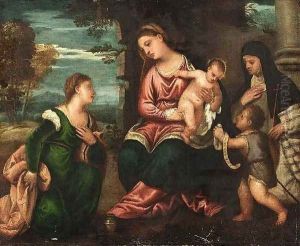Polidoro Lanzani (see Polidoro Da Lanciano) Paintings
Polidoro Lanzani, also known as Polidoro da Lanciano, was an Italian painter from the Renaissance period, born in 1515 in Lanciano, a small town in the Abruzzo region of Italy. Not much is known about his early life and training, but it is believed that he may have been a pupil of Lorenzo Lotto, a prominent Venetian painter of the High Renaissance.
Lanzani's work is characterized by its vibrant color palette and the emotional intensity of the figures he depicted. He was primarily known for his religious paintings, altar pieces, and portraits. His style reflects the transition from the High Renaissance to the Mannerist period, with figures often elongated and placed in complex poses.
In the 1530s, Lanzani moved to Venice, which was then one of the most significant artistic centers in Europe. The influence of Venetian masters, such as Titian, is evident in his work. Polidoro’s paintings from his Venetian period show a mastery of chiaroscuro and a sophisticated use of color, which he likely developed under the influence of the Venetian school.
Among his notable works are 'The Last Supper' and 'Christ Carrying the Cross', which are prime examples of his ability to convey narrative and emotion through composition and the use of light and shadow. Despite his talent, Lanzani did not achieve the same level of fame as some of his contemporaries.
Polidoro Lanzani died in 1565 in Venice. His legacy is that of a skilled painter who contributed to the richness of the Venetian Renaissance, albeit in a more modest capacity compared to the era's giants. His works can be found in various churches and museums, providing insight into the stylistic transitions of Italian Renaissance art.
